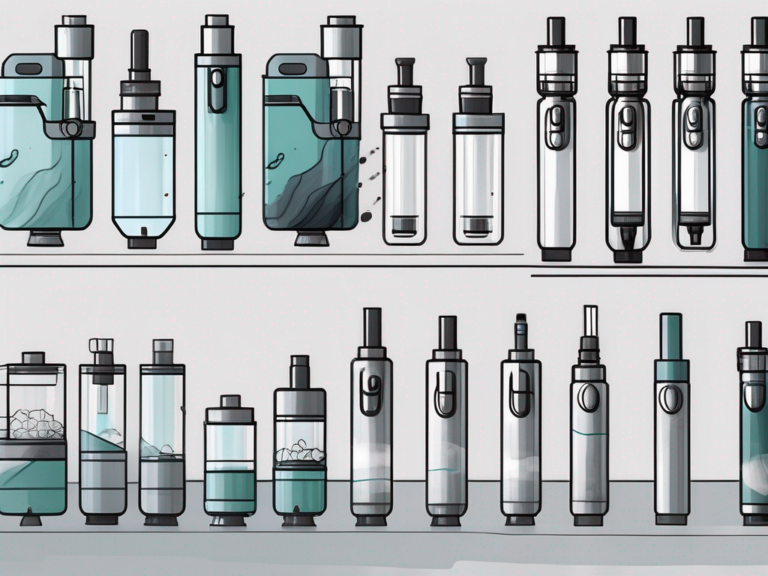how many vapes equal a cigarette
Vaping has become a popular alternative to smoking cigarettes, but many people wonder how it compares in terms of nicotine intake. If you’re interested in knowing how many vapes are equivalent to smoking a cigarette, this article will break down the basics of vaping, compare it to traditional cigarette consumption, and explore the health implications of both practices.
Understanding the Basics of Vaping
What is Vaping?
Vaping involves inhaling and exhaling aerosol, commonly referred to as vapor, produced by an electronic device known as a vape or e-cigarette. These devices work by heating a liquid solution called e-juice, which usually contains nicotine, flavorings, and other additives. When the liquid is heated, it vaporizes and is then inhaled.
One of the key components of a vape device is the atomizer, which is responsible for heating the e-juice and turning it into vapor. The atomizer consists of a coil that heats up when the device is activated, causing the e-juice to vaporize. Different vapes may have varying types of atomizers, such as rebuildable atomizers (RDA) or sub-ohm tanks, each offering a unique vaping experience.
The Different Types of Vapes
There are various types of vapes available in the market, each with its own design and functionality. Some common types include pod mods, vape pens, and box mods. These devices differ in terms of battery capacity, power output, and e-juice capacity. It’s essential to choose a vape that suits your vaping preferences and needs.
Pod mods are compact and easy to use, making them ideal for beginners. Vape pens are slender devices that are convenient for on-the-go vaping. Box mods, on the other hand, are larger and more powerful, allowing for customization of settings such as wattage and temperature. Understanding the differences between these types of vapes can help you make an informed decision when selecting the right device for your vaping journey.
The Composition of Cigarettes
What is in a Cigarette?
A cigarette contains tobacco leaves that have been treated and processed. The process of treating tobacco leaves involves various chemicals and additives to enhance flavor, increase nicotine levels, and prolong shelf life. These additives can include sugars, menthol, ammonia, and hundreds of other compounds. When lit, cigarettes release smoke that is inhaled into the lungs. The smoke contains a mixture of chemicals, including nicotine, tar, carbon monoxide, and various harmful substances. Nicotine is a highly addictive stimulant that affects the brain, leading to dependence and withdrawal symptoms when not consumed. Tar is a sticky residue that can build up in the lungs over time, contributing to respiratory issues and lung damage. Carbon monoxide is a poisonous gas that reduces the blood’s ability to carry oxygen, putting strain on the heart and other organs.
Aside from the well-known components of cigarettes, such as nicotine and tar, there are also trace amounts of heavy metals like lead and cadmium, as well as radioactive elements like polonium-210. These substances are absorbed by the tobacco plant from the soil and can find their way into the human body through smoking. The combustion of tobacco in a cigarette produces thousands of chemicals, many of which are toxic or carcinogenic. These chemicals can damage DNA, leading to mutations that increase the risk of cancer development. In addition to the direct harm caused by smoking, secondhand smoke from cigarettes can also pose health risks to non-smokers, especially children and pregnant women.
The Impact of Cigarettes on Health
Smoking cigarettes is widely recognized as a significant risk factor for various health conditions. It has been linked to an increased risk of lung cancer, chronic obstructive pulmonary disease (COPD), heart disease, stroke, and many other serious ailments. The addictive nature of nicotine in cigarettes makes it challenging for smokers to quit, despite the potential health consequences. The long-term effects of smoking can be devastating, with many individuals experiencing a decline in lung function, reduced quality of life, and premature death as a result of smoking-related diseases. Quitting smoking is one of the most important steps a smoker can take to improve their health and reduce their risk of developing smoking-related illnesses.
Comparing Vape and Cigarette Consumption
Measuring Vape Usage
It’s important to note that the amount of nicotine consumed through vaping can vary based on the device, e-juice strength, and individual vaping habits. E-juices are available in different nicotine concentrations, ranging from no nicotine to high levels. Vapers can choose the strength that best suits their needs and gradually adjust their nicotine intake or even opt for nicotine-free e-juices.
Furthermore, the vaping experience can also be influenced by factors such as the type of coil used in the device, the wattage settings, and the frequency of vaping sessions. All these variables play a role in determining the overall nicotine delivery and satisfaction for the vaper.
Equating Vape Usage to Cigarette Consumption
Since there are many factors influencing nicotine absorption in the body, it is difficult to give a straightforward answer on how many vapes equal a cigarette. However, it has been estimated that one milliliter (ml) of e-juice with an average 6-milligram nicotine concentration is roughly equivalent to smoking one tobacco cigarette. Nevertheless, individual preferences and vaping behavior can greatly influence the comparison.
Moreover, the sensation and ritual of smoking a cigarette versus vaping are inherently different. While smoking involves combustion and the inhalation of smoke containing numerous harmful chemicals, vaping heats e-liquid to create an aerosol for inhalation. This distinction not only affects the delivery of nicotine but also the overall experience and potential health impacts on the user.
Health Implications of Vaping vs Smoking
As the debate over vaping versus smoking continues, it’s crucial to delve deeper into the intricacies of how each activity impacts our health. While both vaping and smoking have short-term effects on the body, the nuances of these repercussions are worth exploring further.
Short-term Effects of Vaping and Smoking
Vaping and smoking both have immediate impacts on the body, albeit with varying degrees of intensity. Short-term effects of vaping may manifest as dry mouth, throat irritation, and an accelerated heart rate. Conversely, smoking cigarettes can induce sensations of dizziness, persistent coughing, and difficulty breathing. These contrasting reactions highlight the diverse ways in which these habits affect our bodies in the short run.
Moreover, beyond the physical symptoms, the psychological aspects of vaping and smoking cannot be overlooked. The ritualistic nature of smoking a cigarette or vaping a flavored e-liquid plays a significant role in addiction and habit formation. Understanding these behavioral components is essential in comprehending the allure and challenges of quitting these habits.
Long-term Effects of Vaping and Smoking
While the long-term effects of vaping are still shrouded in uncertainty, emerging research suggests that it may present a less detrimental option compared to smoking traditional cigarettes. The noxious cocktail of toxic substances and carcinogens found in cigarette smoke poses a grave risk to long-term health, contributing to a myriad of severe medical conditions. In contrast, vaping eliminates exposure to many of these harmful chemicals, potentially reducing the overall health risks associated with smoking. However, the lingering questions surrounding the impact of long-term vaping on respiratory health underscore the need for comprehensive scientific inquiry and ongoing studies.
Exploring the evolving landscape of vaping and smoking reveals a complex interplay of biological, behavioral, and societal factors that shape our understanding of these practices. By delving into the nuances of short-term and long-term effects, we can glean valuable insights into the intricate relationship between vaping, smoking, and human health.
Regulatory Measures on Vapes and Cigarettes
Current Regulations on Cigarettes
Cigarettes are heavily regulated in most countries due to their significant health risks. Regulations typically focus on advertising restrictions, pack warnings, and age restrictions to discourage smoking initiation. Additionally, measures such as higher taxes on tobacco products aim to deter consumption and fund tobacco control programs.
In recent years, there has been a growing awareness of the dangers associated with smoking, leading to more stringent regulations. For example, some countries have implemented plain packaging laws, which require all cigarette packs to have standardized designs and eliminate branding elements. This measure aims to reduce the appeal of cigarette packaging, especially to young people, who are particularly susceptible to marketing tactics.
Furthermore, many countries have implemented smoke-free policies, which prohibit smoking in public places such as restaurants, bars, and parks. These policies not only protect non-smokers from the harmful effects of secondhand smoke but also create an environment that discourages smoking initiation and supports smokers who want to quit.
Current Regulations on Vapes
The regulation of vapes is still evolving in many jurisdictions. Some countries have implemented strict rules, including product quality control, age restrictions, and limitations on advertising and flavors. The aim is to strike a balance between allowing adult smokers access to less harmful alternatives while preventing underage vaping and potential health risks associated with poorly manufactured products.
One of the key challenges in regulating vapes is the rapid evolution of the market. With new products constantly entering the market, regulators face the task of keeping up with the latest developments and ensuring that regulations remain effective. This includes monitoring the ingredients used in vape liquids and the safety of vaping devices to protect consumers from potential harm.
Moreover, some countries have introduced specific regulations for vaping in public places, similar to those in place for cigarettes. These regulations aim to address concerns about secondhand vapor and create a consistent approach to smoking and vaping in shared spaces.
As the popularity of vaping continues to grow, regulatory bodies are also focusing on education and awareness campaigns to inform the public about the potential risks and benefits of vaping. These campaigns aim to provide accurate information to both smokers and non-smokers, helping them make informed decisions about their health.
In conclusion, while regulations on cigarettes have been in place for many years, the regulation of vapes is still a work in progress. As research continues to uncover more about the long-term effects of vaping, it is crucial for regulatory bodies to adapt and refine their measures to ensure the protection of public health. By staying informed and adhering to relevant regulations, individuals can make choices that align with their health goals and contribute to a safer and healthier society.






